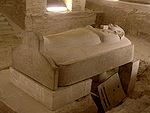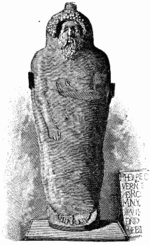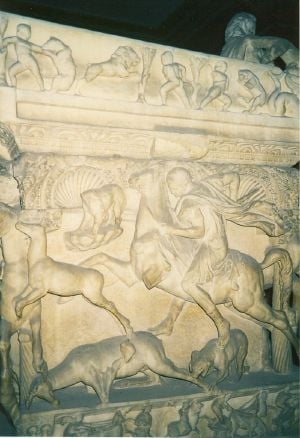Difference between revisions of "Sarcophagus" - New World Encyclopedia
(started) |
|||
| Line 1: | Line 1: | ||
| − | {{Claimed}} | + | {{Claimed}}{{Started}} |
[[Category:Politics and social sciences]] | [[Category:Politics and social sciences]] | ||
[[Category:Anthropology]] | [[Category:Anthropology]] | ||
| Line 8: | Line 8: | ||
[[Image:Worms_sarcophagi.jpg|right|thumb|150px|Roman-era Sarcophagi at [[Worms, Germany]]]] | [[Image:Worms_sarcophagi.jpg|right|thumb|150px|Roman-era Sarcophagi at [[Worms, Germany]]]] | ||
[[Image:Anthropoid sarcophagus discovered at Cadiz - Project Gutenberg eText 15052.png|150px|thumb|right|Anthropoid sarcophagus discovered at [[Cádiz]]]] | [[Image:Anthropoid sarcophagus discovered at Cadiz - Project Gutenberg eText 15052.png|150px|thumb|right|Anthropoid sarcophagus discovered at [[Cádiz]]]] | ||
| + | [[Image:Detail sarcophagus Istanbul Arkeoloji Muzesi.jpg|right|thumb|Detail of a stone sarcophagus in the [[Istanbul Archaeology Museum]] showing a hunting scene.]] | ||
| − | A '''sarcophagus''' is a stone container for a [[coffin]] or body. The word comes from [[Greek language|Greek]] "sarx" meaning "flesh" | + | A '''sarcophagus''' is a stone container for a [[coffin]] or body. The word comes from [[Greek language|Greek]] "sarx" meaning "flesh," and "phagien" meaning "to eat," so that ''sarcophagus'', which means "eater of flesh." The 5th century B.C.E. [[Ancient Greece|Greek]] historian, [[Herodotus]], noted that early sarcophagi (the plural) were carved from a special kind of rock that consumed the flesh of the [[corpse]] inside. In particular, coffins made of a [[limestone]] from [[Assus]] in the [[Troad]] known as ''lapis Assius'' had the property of consuming the bodies placed within them, and therefore was also called ''sarkophagos lithos'' (flesh-eating stone). All coffins made of limestone have this property to a greater or lesser degree, and the name eventually came to be applied to stone coffins in general. |
Sarcophagi were usually made by being carved, decorated or built ornately. Some were built to be freestanding above ground, as a part of an elaborate tomb or tombs. Others were made for burial, or were placed in [[crypt]]s. In Ancient Egypt, a sarcophagus was usually the external layer of protection for a [[royal]] [[Mummy#Mummies_in_ancient_Egypt|mummy]], with several layers of coffins nested within. | Sarcophagi were usually made by being carved, decorated or built ornately. Some were built to be freestanding above ground, as a part of an elaborate tomb or tombs. Others were made for burial, or were placed in [[crypt]]s. In Ancient Egypt, a sarcophagus was usually the external layer of protection for a [[royal]] [[Mummy#Mummies_in_ancient_Egypt|mummy]], with several layers of coffins nested within. | ||
| Line 15: | Line 16: | ||
The sarcophagus was also used to protect dead bodies. | The sarcophagus was also used to protect dead bodies. | ||
| − | |||
| − | |||
| − | |||
| − | |||
| − | |||
| − | |||
| − | |||
| − | |||
| − | |||
| − | |||
| − | |||
| − | |||
| − | |||
| − | |||
| − | |||
| − | |||
| − | |||
| − | |||
| − | |||
| − | |||
| − | |||
| − | |||
| − | |||
| − | |||
| − | |||
| − | |||
| − | |||
| − | |||
| − | |||
| − | |||
| − | |||
| − | |||
| − | |||
| − | |||
| − | |||
| − | |||
| − | |||
{{Credit1|Sarcophagus|99489906|}} | {{Credit1|Sarcophagus|99489906|}} | ||
Revision as of 05:45, 7 September 2007
A sarcophagus is a stone container for a coffin or body. The word comes from Greek "sarx" meaning "flesh," and "phagien" meaning "to eat," so that sarcophagus, which means "eater of flesh." The 5th century B.C.E. Greek historian, Herodotus, noted that early sarcophagi (the plural) were carved from a special kind of rock that consumed the flesh of the corpse inside. In particular, coffins made of a limestone from Assus in the Troad known as lapis Assius had the property of consuming the bodies placed within them, and therefore was also called sarkophagos lithos (flesh-eating stone). All coffins made of limestone have this property to a greater or lesser degree, and the name eventually came to be applied to stone coffins in general.
Sarcophagi were usually made by being carved, decorated or built ornately. Some were built to be freestanding above ground, as a part of an elaborate tomb or tombs. Others were made for burial, or were placed in crypts. In Ancient Egypt, a sarcophagus was usually the external layer of protection for a royal mummy, with several layers of coffins nested within.
The sarcophagus was also used to protect dead bodies.
Credits
New World Encyclopedia writers and editors rewrote and completed the Wikipedia article in accordance with New World Encyclopedia standards. This article abides by terms of the Creative Commons CC-by-sa 3.0 License (CC-by-sa), which may be used and disseminated with proper attribution. Credit is due under the terms of this license that can reference both the New World Encyclopedia contributors and the selfless volunteer contributors of the Wikimedia Foundation. To cite this article click here for a list of acceptable citing formats.The history of earlier contributions by wikipedians is accessible to researchers here:
The history of this article since it was imported to New World Encyclopedia:
Note: Some restrictions may apply to use of individual images which are separately licensed.



